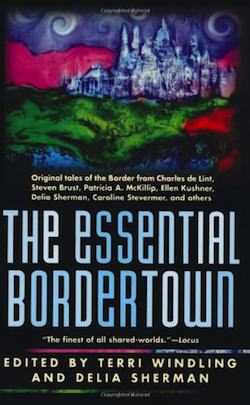Welcome back to the final post in the Rereading Bordertown series. This entry covers the last of the original Bordertown books, the anthology The Essential Bordertown, edited by Terri Windling and Delia Sherman.
The original set of books kept the Border open for twelve years. Borderland, the first anthology, was published in 1986, and The Essential Bordertown was published in 1998. That twelve-year run is almost as long as the thirteen years between The Essential Bordertown and this year’s Welcome to Bordertown (eds. Holly Black and Ellen Kushner). I point this out because even in an ongoing set of stories, twelve years is a long time. The world changed, and Bordertown changed with it, and those changes meant Bordertown looked different just before the Border closed as it did when it first opened.
Time may not change the lands among the Border at the same pace as it changes the World, but it does alter them, and those transformations are reflected in this book. In The Essential Bordertown, we read stories of the Riverfolk, and even one set on the Mad River itself. We visit the Bordertown Preparatory Academy. We see magics that draw from voudou tradition, from the rituals of the Dia de los Muertos. We meet Screaming Lord Neville, and witness Bordertown’s first coming out story. The place seems fuller, more real, when we see all the pieces of it, when we meet the varieties of people who live in these different places.
This anthology is also the first time we see people choose to leave Bordertown, and return to the place they were before, in Felicity Savage’s “How Shannaro Tolkinson Lost and Found His Heart.” Even though Savage’s piece is partially the story of someone who never truly wanted to come to Bordertown in the first place, her writing makes concrete an idea that has run through the entirety of the series: as magical a place as Bordertown is, it is just a place. It is not for everyone, and is not a cure for the things that were wrong before you got there.
As with the previous anthologies, there is interstitial material serving as introduction to and connection between the stories here. Written in the style of entries in a guidebook for the newly arrived—both Elvin and human—these brief essays serve as both introductions to the themes of the stories they precede and as an introduction to Bordertown for readers who haven’t ventured there before this book. (A necessary thing I remember trying to find the other anthologies when The Essential Bordertown was published, and it was impossible, and as I’ve noted previously, the novels focus less on the setting and its rules than the anthologies do.)
Even after this reread, I still can’t quite say what was the exact thing that made me know that Bordertown was mine, that I would rather stumble along a city street than fall out of the back of a wardrobe if given the choice. I cannot annotate the magic, only tell you that it is real.
The stories in The Essential Bordertown stuck with me, long after my first reading of them. I’ll never forget the first time I taught Charles de Lint’s elegant and heartbreaking “May This Be Your Last Sorrow,” and sent a new set of readers along the path to Bordertown. I cannot count the number of times I replaced the paper marking what is, perhaps, my favorite Bordertown quotation, from Ellen Kushner’s “Hot Water: A Bordertown Romance.” “The stars are different here, and there’s a reason for that. It’s so we can pick one that no one else has, and try to live up to it.” That was always something I could do I could find Bordertown in the stars, even when I couldn’t find it on a map.
The screensaver on my computer tells me “Bordertown Lives.” I truly believe it does. Bordertown lives in each of us who scoured the shelves of libraries and used bookstores, looking for copies of anthologies that were our guidebooks. It lives in each of us for whom these stories were maps to a place we already knew. Bordertown lives in everyone who has been brave enough to look for a place that is truly home no matter how strange or how broken that place is, no matter how strange or how broken they were when they went looking. Illirien ethi’Kiri ecu va’me. May you find the Road.
Kat Howard‘s short fiction has been published in a variety of venues. You can find her on Twitter, at her blog, and at Fantasy-matters.com. She still wants to live in Bordertown.










